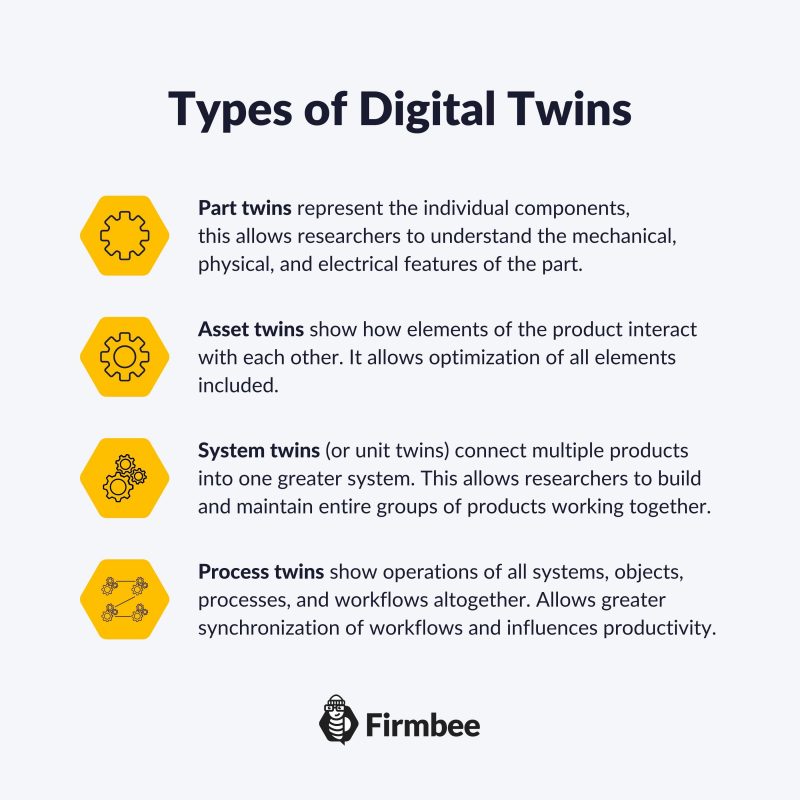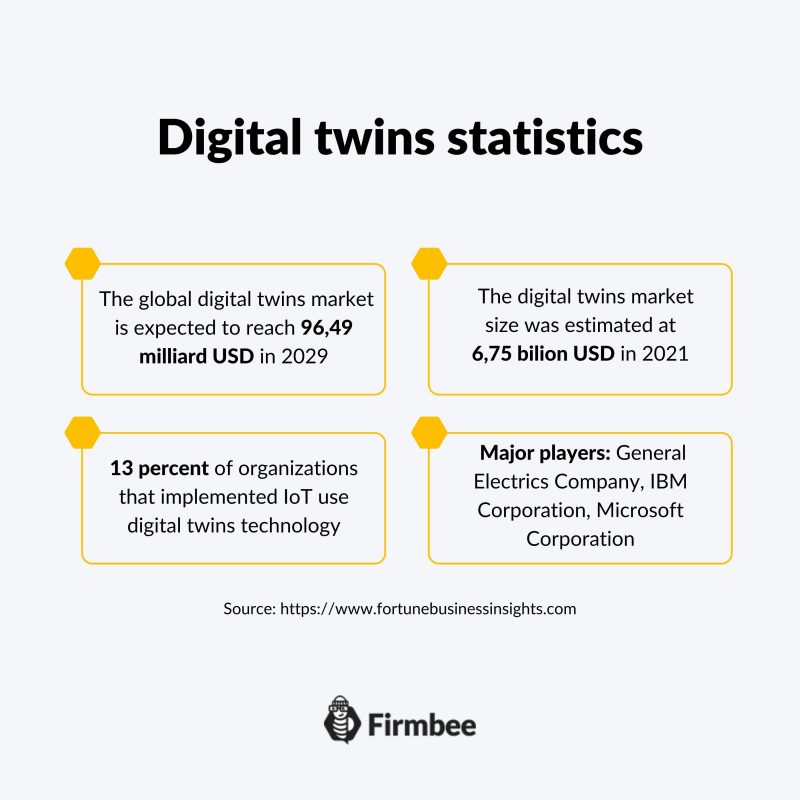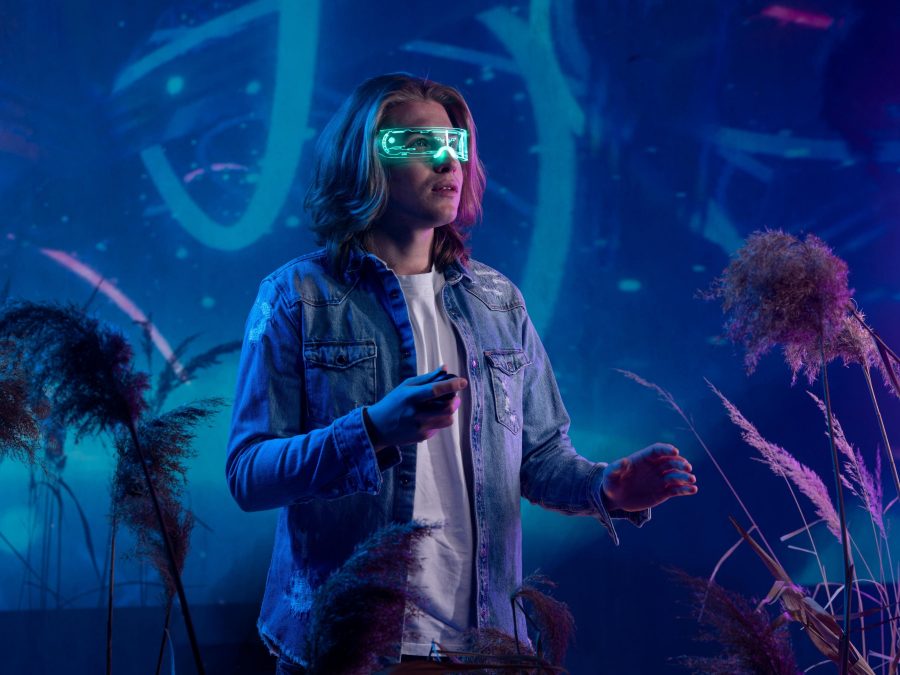Were you scared watching Black Mirror? Have you thought of the future with apprehension? We have a message for you – there is a technology that should start you thinking. The unreal world of Black Mirror becomes a reality. Let’s talk about digital twins.
Digital twins – table of contents:
- What is a digital twin?
- What are the main types of digital twins?
- What is the difference between digital twins and simulation?
- Main areas of application of digital twins
- Advantages of digital twins for the industry
- Future applications of digital twins
- Threats and concerns
What is a digital twin?
A digital twin is a model in virtual reality that is designed to reflect another physical object that exists in the real world. The digital twin is an exact replica of an object, not just a picture or a scheme, or not even a simulation of the object, but a replica that reflects all the features of the object. The replica or the digital concept that contains the information about the real object can be created and exist as the object on its own and be linked with its physical model permanently.
All this means that the concept of digital twins contains three major elements: real space with the real object, virtual space with virtual objects, and the connection between them that allows a constant flow of information between virtual space and real space.
The idea of using the technology of digital twins was first introduced in 1991 in the publication entitled Mirror Worlds: or the Day Software Puts the Universe in a Shoebox by Yale computer expert David Gelernter. In the publication, Gelernter argues that exact representations of the world accessible through the screen of the computer will be available to everybody in the close future. In his vision, people will be able to interact with mages the same way they interact with the reality experienced every day. Gelernter predicts that computers will be used differently and explains how it is possible to build a replica of the world with today’s technologies.
The concept of digital twins was also developed by professor Michael Grieves, who is credited with the first application of the idea to be used in manufacturing. He presented the concept in 2002 at the event devoted to Product Life Management. Initially, the concept was referred to as the Mirrored Spaces Model. His articles and publications praise the perfection and usability of digital products that are not only indistinguishable from their real models and great for testing and simulation purposes.
However, the technology of digital twins is not as recent as it seems. NASA has used digital twin technology already in the 1960s during their space exploration missions when spacecraft were replicated on earth and used for testing and research. The mere term “digital twins”, as we understand it today, was used by NASA’s specialist John Vickers in 2010.
What are the main types of digital twins?
There are several types of digital twins, but the main difference is in the area or depth of application, hence we can talk about: part twins, asset twins, system twins, or process twins. Part twins are very basic, small twins of working components. Asset twins are used for so-called assets formed from two separate components working together. Asset twins allow observation and measurement of the two components in action.
System twins are on the next level of complexity. Those twins replicate entire functioning systems and allow studying bigger physical objects. Process twins reflect the work of huge systems such as factories or other big structures. Process twins help to observe complicated interactions and allow synchronization of elements to achieve the highest possible efficiency of operation.

What is the difference between digital twins and simulation?
The concepts of simulations and digital twins are sometimes used in reference to the same digital objects, but they are different things and the underlying concepts are different. Simulation is usually created in a platform such as CAD software or other and it doesn’t have to have any relation with any real physical object.
A digital twin, on the contrary, has to be created in connection with the real physical object. The whole process of the creation of digital twins is based on real data related to the object. Digital replica is linked with the real object through IoT sensors and gets real-time data, which means that data is constantly updated. The flow of information between the digital twin and the object is two-way. The results of processes that occur in digital twins may be used back with the real, original object.
Main areas of application of digital twins
The creation of digital twins is still very expensive and laborious and currently, the usage of digital twins is limited to certain areas. They are used extensively in the areas such as:
- Urban planning
- Automotive industry
- Healthcare
- Manufacturing industry
- Power plants
Digital twins of the towns and cities can show realistic spatial data in 3D and 4D systems. The application of twins allows for more consistent urban planning of the environment. Currently, more and more cities decides to join Shanghai and Singapore and create their twins. All data is available in real-time so it improves greatly all the operations related to the design of streets, buildings, and transport systems. Most of the new cities that are being built recently in the Middle East have their digital twins created at the same time.
The second very important application of digital twins we may find in the automotive industry. Cars have complicated structure that involves many systems that have to work together without the risk of breakage. Digital twins help to increase the performance and efficiency of vehicles. In the case of cars that run with the use of the support of AI digital twins allow an early check of the validity of prognostics.
Initially, all the digital twins used in the healthcare industry were replicas of products and equipment. Currently, the digital twin concept in healthcare is being applied to patients that need to be diagnosed and monitored. Fully personalized models of patients are being built. Those replicas allow storage and tracking of lifestyle parameters. Digital twins of the whole population will enable greater pattern search.
Digital twins show the functioning of the object through its whole life cycle. The very first application of digital twin technology was in manufacturing. All complicated products can be produced with the use of digital twins and those may be utilized at every stage of the production.
Digital twins help to set the schedule for such huge, complex entities as power plants. All sorts of large engines and turbines have to be maintained regularly and their operation depends strongly on cyclical processes that have to be managed orderly to keep them in operation. Digital twins seem to be indispensable here.

Advantages of digital twins for the industry
- Risk reduction
- Quality of products
- The cost of maintenance is lower
The health and safety of employees as well as of the environment can be protected by the usage of digital twins software. Business objectives can be kept through the reduction of accidents during the production process. With digital twin technology, it is much easier to avoid costly downtime.
With the better insight provided by simulations run through digital twin technology companies can improve the quality of their products and customize them in real-time, when the necessity occurs.
Digital twins provide the company with predictions related to the whole process of production. This allows them to schedule repairs or changes of parts before anything breaks down.
Future applications of digital twins
There is no limit of the future application of digital twins. Currently, digital twins are still learning their new skills, but the amount of money invested and the amount of cognitive power increase each year exponentially. Nowadays the market for digital twins is growing mainly in several leading sectors such as manufacturing, automotive, aviation, energy, healthcare, and logistics, but it is predicted that its future development will cover all possible areas of human activity.
- Smart cities
- The Earth and the agriculture
- Human digital twins
The main reason for the scientists that wish to create digital twins for cities and towns, is the carbon emission that is generated by huge urban structures. It has been estimated that cities produce approximately 70% of carbon and consume more than two-thirds of the world’s energy. It is expected that many cities such as Miami, New York, San Diego, and Jakarta, along with the significant area of land in China and India will be underwater by 2050.
More sustainable planning of urban development and better control over time and resources used by the construction industry (currently highly inefficient) may help reduce the waste of energy and emission of carbon to the atmosphere. Digital twins of cities are the solution to the problem – they can help optimize all processes of urbanization such as design, planning, construction, and day-to-day management. Digital twins can reduce the wastage of energy coming from poorly insulated, old buildings, as well as lower the emission coming from the ineffective traffic flow.
Currently, there are many urban city projects all over the world in progress. Those cities don’t have their digital twins yet, but it is there to come if governments and local states expect to maintain them flawlessly. The scale of the project is immense – most the huge cities aim to be smart sooner or later. Ministry of Housing and Urban Affairs of the Government of India has selected 100 cities to become smart by 2023. The states and the government are the major investors and initiators of the project of Indian smart cities. All smart Indian cities are expected to allow the participation of smart people through the use of ICT (mobile-based tools).
China has a higher number of smart city projects in operation – almost 500. There are 100 leading cities, with the most known on the list such as Beijing, Shanghai, Shenzhen, Hangzhou, Chengdu, and Wuhan. Most of them are still under construction, but it is expected that China will be the very first of the countries on Earth to be fully smart in the future.
Some of the biggest smart cities are located in the United States, and those are New York, Los Angeles, San Francisco, Phoenix, Salt Lake City, Denver, Miami, and Minneapolis. London and Dubai are becoming smart as well, similar to Paris, Jakarta, Melbourne, Barcelona, and Taipei. As we see most of the biggest cities aim to become smart in the nearest future, and all of them will have their digital twins eventually.
For further control over the emission of carbon dioxide, the twin of Earth is being developed. It is stated that the digital twin should help to predict changes in climate and predict the outcomes of such changes. The project started in mid-2021 and it is expected that it will run for ten years at least. In the end, the full, highly accurate digital model of the Earth will be designed. The replica of Earth aims to represent all processes that occur on the Earth’s surface. Food, water, and energy will be monitored through this twin as well.
Some of the solutions related to digital twins are used in agriculture already to boost the production of crops such as corn, wheat, and soy. The sensors monitor the weather and the quality of the soil. Natural events such as tornados, floods, and droughts pose a risk to food security, accurate predictions provided by digital twin technology may be the solution for agriculture.
A digital world of smart digital cities may need digital human inhabitants to thrive. Humans can have their digital twins and the technology already allows the creation of such entities. Digital twins of humans that will lead digital life are expected to become in use before the end of the decade, which is pretty soon. Those digital twins are predicted to be thinking and learning from real models – humans.
Threats and concerns
Digital twins of humans can be useful for employers, businesses, and companies, but would it be equally beneficial for individual people? It may prove highly unethical and detrimental to human interactions. Human digital twins that will learn the needed skill may replace humans and make them redundant. Employers may decide to employ a digital human instead of a real person, which is only understandable comparing the costs of living of both creatures.
The end of freedom and free will. Among the praises over the functionalities of cities’ digital twins are those that may not be as beneficial for humans at all. It is being said that governments, or other managing entities, may be able to control all vital aspects of living in urban space. The digital twin will be able to control traffic flow – meaning that one may not be able to travel where he wishes and to control the temperature of rooms and water used in citizens’ flats – meaning that you may not be able to have long showers anymore.
The amount of power and control granted by the technology of digital twins to unknown, unpredicted authorities that will govern our cities is excessive and dangerous – there will be a million ways to punish disobedient individuals, just by the manipulation of the immediate environment of the person (lack of access to services, restricted amount to resources, limited ability to travel).

Real humans may be forced to live in small, confined places, with no access to nature or other living creatures. As retail companies plan to move into virtual reality, shopping will be realized throughout virtual mediums as well. It seems that some of the major designers of digital twins technology have forgotten that shopping is not only about acquiring goods but has more to do with: socializing, entertainment, and refreshment for the mind.
Currently, there are living examples of smart cities that can be analyzed in relation to ethics and freedom issues. Beijing is being praised for its payment system that allows cashless existence across the whole city – would all citizens of the world be forced to have a smart device? Guangzhou has replaced ID cards with smartphones – the system is fully operational, but allows a greater amount of control over the individual citizens than was ever possible. People criticizing the government don’t have a chance to hide in Guangzhou anymore.
The most crucial question about digital twins of the real space (cities, Earth, objects) and digital twins of humans is about the link between the human and his replica that is required for the whole process – would it be a smartphone or other device. The change into digital reality seems to be necessary for some areas of human life, but the technology of digital twins is very energy-consuming. Should we not ask ourselves if all the applications of the technology of digital twins are really necessary in all aspects of our living and who exactly wishes to benefit from having making human prototypes live with thinking twins in some unreal, unnatural, and fully-controllable world?
If you like our content, join our busy bees community on Facebook, Twitter, LinkedIn, Instagram, YouTube, Pinterest.
Author: Robert Whitney
JavaScript expert and instructor who coaches IT departments. His main goal is to up-level team productivity by teaching others how to effectively cooperate while coding.
The most important questions
-
What are digital twins?
A digital twin is a virtual model designed to accurately reflect a physical object. It is an exact replica of an object, not just a picture or a scheme, or not even a simulation of the object, but a replica that reflects all the features of the object.
-
Why are digital twins important?
Throughout the entire manufacturing process, from conception and preparation to the upkeep of established infrastructure, digital twins are utilized. By utilizing a digital twin prototype, you can observe your machinery consistently and analyze performance statistics that demonstrate the efficiency of a specific component or the entirety of your factory.
-
What are digital twins used for?
Digital twins are virtual replicas of physical objects, systems, or processes that are used in various industries for different purposes, like design, testing, maintenance, optimization, training, and education to improve efficiency, reduce costs, and enhance performance.


















